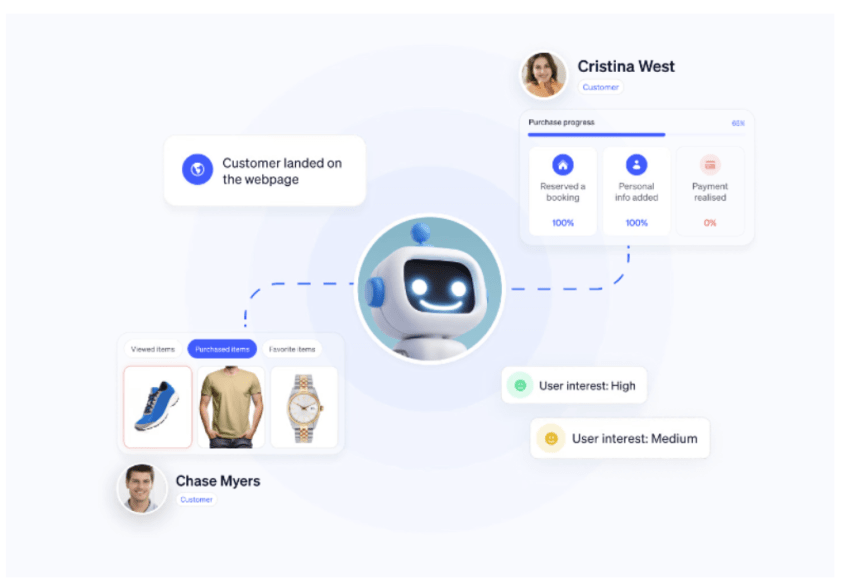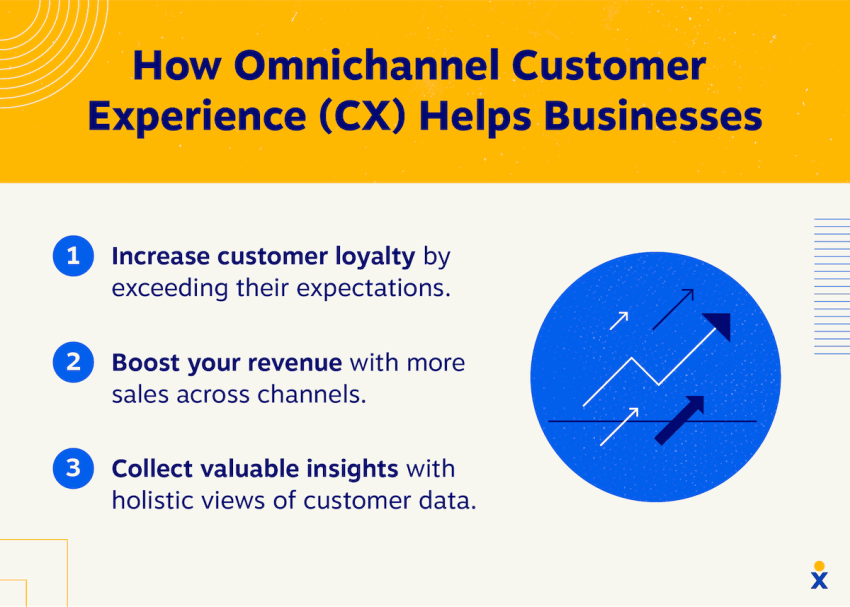Why is everyone talking about digital customer engagement like it’s the Holy Grail of CX?
Because customers expect support that feels steady and dependable, no matter which channel they choose to reach out via. Many companies try to meet that demand by offering help everywhere, but scattered tools often lead to slow replies and repeated conversations, which cost them valuable customer relationships.
The real fix isn’t cutting the number of channels you use. It’s bringing them together with a solid digital customer engagement strategy that keep conversations connected and easy to manage.
What Is Digital Customer Engagement?
Digital customer engagement is the way a company connects with customers through online channels. This includes chat, email, SMS, messaging apps, social platforms, and any other place where a person can reach a business without picking up the phone or walking into a store.
Digital engagement covers the entire customer journey, from initial contact to post-purchase followups. The goal is to help customers quickly, reliably, and in a way that feels clear and human.

Offline vs. digital engagement
The difference between offline and digital customer engagement is primarily the channels used for each interaction:
- Offline engagement happens face to face in a physical store, where you can see, touch, or try on products, or by phone, where you speak with a human being directly. The downside is that it lacks the real-time customer data and automation capabilities that are used online.
- Digital engagement takes place on the internet where businesses can personalize each customer’s experience and automate communication (with chatbots for example). It’s great for quickly asking questions or solving minor issues. The downside is that it lacks the tangible and human experience of offline settings.
A digital channel offer more flexibility, while offline options usually feel more personal – but a strong CX strategy uses both, depending on what each customer needs or prefers.
Many teams now rely on AI systems, chat assistants, and personalization to help manage online conversations. Other technologies like automation platforms, CRM systems, and omnichannel strategies help maintain consistent interactions across digital touchpoints.

We’ll dive into these tools later, but for now, the key idea is that they make it easy for organizations, especially small businesses, to provide their customers with efficient help when they need it.
Why Digital Customer Experience Matters
Customers reach out on their own terms now. They expect quick answers at any time of day, steady communication, and the ability to move between channels without having to repeat themselves. When a business can meet them where they are — online, on mobile, or inside an app — it’s super convenient for the customer.
Digital engagement also matters for businesses. Patterns and needs become easier to spot, common questions or issues surface more often, and support teams have better context in which to work. This leads to faster replies, smoother interactions, and a better overall experience.
But here’s the key. Strong digital engagement doesn’t replace personal service. It strengthens it. When customers know they can count on a helpful reply wherever they reach out, they’re way more likely to return when they need something new or recommend the brand to others.
What happens when your digital CX suffers?
Customer experience should be a primary business goal for every organization. Without a strong CX, here’s what you can expect to deal with.
You frustrate your customers
An unresponsive digital channel creates a frustrating customer experience, leading to a low engagement rate, a high abandonment rate, and overall dissatisfaction.
As frustration increases, both customer loyalty and customer retention fall. And this can happen quickly; a PWC study found that customers would stop doing business with brands they loved after a single bad experience.

Your brand reputation tanks
You work hard to build brand awareness and loyal customers, but an inconsistent or poor digital interaction can quickly damage your brand’s reputation, especially as customers share negative experiences on social media or review platforms.
This damage can be difficult to recover from, especially since customer service is a primary factor that impacts purchasing decisions for many customers. Consistent online reviews saying your brand is unresponsive can turn away potential customers.

You lose revenue opportunities
Overlooked or mishandled interactions often result in lost sales opportunities. When digital interactions are slow or inconsistent, potential customers move on quickly. Missed messages, delayed responses, or broken chat links can cause potential customers to move on quickly—straight to competitors who make it easier to connect.
Customer loyalty takes time to earn but can disappear in a single poor experience—and once a sale is lost, it’s rarely recovered.
Your operation becomes inefficient
Disjointed digital channels can quickly lead to operational inefficiencies. Customer queries that should be quickly handled get bounced around to multiple agents or lost in the process altogether.
Furthermore, failing to implement customer engagement platforms and strategies can lead to burned-out agents who feel overwhelmed with the disorganized system and poor subsequent customer engagement metrics.
Benefits of Digital Customer Engagement
Here are some of the strongest gains businesses see when they invest in digital engagement:
- Faster replies across channels. Customers get help without long waits or repeated follow-ups.
- Better continuity. Notes from conversations stay intact as customers switch between chat, email, or messaging apps.
- Lower costs. Compared to traditional methods, outreach through email, social media, and chatbots is more efficient.
- More visibility for support teams. Common behaviors, complaints, and customer needs are easier to become aware of, enabling better product improvements and marketing strategies.
- Higher satisfaction. When people get clear answers quickly, they feel taken care of and are more likely to stay loyal.
- More flexibility for customers. They can reach out from wherever they are, using the channel that feels easiest at the moment.
- Better CX. With interactive tools, personalized journeys, real-time support, and user-friendly digital platforms, current and potential customers have a better experience.
- Broader global reach. Digital CX allows you to expand your market opportunities beyond local areas.
- Stronger support for agents. Tools can sort requests, route questions, and reduce manual tasks so teams can focus on more complex problems, such as those needing human help.
- Competitive edge. Although more and more companies are going online, you can still take advantage of digital CX by responding quickly and efficiently to your customers and helping your brand stand out.
Examples of Digital Customer Engagement
Here’s a list of general digital customer engagement examples:
- Customers using a website’s live chat to get quick support.
- A customer replying to a brand’s social media post or poll.
- Users checking order updates through a company’s mobile app.
- A customer leaving a review or rating a recent purchase online.
- Subscribers opening and responding to personalized email updates.
- Customers joining a loyalty program through an online portal.
- A visitor interacting with a chatbot to find product information.
- A customer booking an appointment through a self-service scheduler.
- Participants joining a webinar or virtual event hosted by a company.
- Users providing feedback through a post-purchase survey.
Now, here are four real-world examples of digital customer engagement being used by successful companies:
Sephora’s virtual assistant
Sephora uses AI-powered facial recognition in its mobile app to let customers virtually try on products, access information, and make purchases easily. This approach resolved customer hesitation about online buying and created a personalized experience, boosting customer satisfaction and sales.

Domino Pizza’s ordering app
Domino’s offers digitized ordering with an app featuring real-time delivery tracking, AI-predicted customer preferences, voice ordering, and gamification. Over 70% of Domino’s sales now come through digital channels, improving customer loyalty and satisfaction with faster and more transparent delivery.

Renault’s AI assistant
By using an AI-powered virtual assistant to engage customers and provide convenient support via WhatsApp, car manufacturer Renault reduced customer service wait times by 93%.

Spotify’s “Wrapped” experience
Spotify uses listening history and user data to generate a personalized “year in review” for each customer, turning a passive subscription into an interactive, share-worthy moment.
This feature was launched in 2015, and in 2021 60 million Spotify Wrapped stories were shared on social media, which more than doubled the year after. And between 2020-2021, there was a 461% increase in tweets about Spotify Wrapped.

To give you a better idea at how the customer experience improves via digital engagement, take a look at these stats:
- Companies that use AI report a 20% increase in customer satisfaction.
- 88% of customers say the experience a company provides is as important as its products or services.
- 58% of people have changed their customer expectations since businesses starting using technologies like chatbots and voice assistants.
- 34% of retail customers would be comfortable speaking with customer service through an AI chatbot instead of live chat.
How to Pivot Your Digital Engagement Strategy to Improve CX
Strong digital engagement doesn’t happen by accident. Here’s how to refine your digital strategy to improve the customer journey and create more meaningful customer experiences.
1. Set clear engagement goals
Start by defining exactly what success looks like—that is, which specific outcomes you want from your digital channels. This could be to boost response rates, increase customer satisfaction, or improve long-term loyalty. Clear goals guide your digital initiatives and help your team stay aligned. But just pick one or two priorities first so the work doesn’t feel overwhelming for your team.

Example: A support team notices that many customers drop out of chat when replies take too long. They set a target to lower their first-reply time and redesign internal workflows to make that possible.
2. Identify your audience and preferred channels
Different people prefer different ways of reaching out. Younger customers may message on social platforms, busy people tend to shoot you an SMS text, while long-time customers might enjoy sticking to email. Study where conversations already happen and build your presence around those habits; mapping customer behavior helps you allocate resources efficiently.

Example: A retailer sees that most questions come from Instagram messages rather than email. They shift more agents to watch that inbox and set up automated quick-reply options to handle common questions about shipping and returns.
3. Choose the right digital tools
Pick the digital tools that simplify customer communication and give your team full context for every customer interaction.
For instance, a CRM keeps all message history and account details in one place, so customers don’t have to repeat themselves. Chatbots or virtual assistants can handle simple customer inquiries, offer self-service options, or route requests to the right person to provide faster answers. And analytics tools can show you patterns in engagement that help you improve your business. You can also automate workflows, streamlining processes like order tracking, appointment scheduling, and issue resolution.

Example: A small business adopts a single digital platform to manage chat, SMS, and email. Agents no longer have to switch between tabs, so replies are faster and customers don’t repeat information, and chatbots take care of simple requests.
Common digital and AI tools for digital customer engagement:
- AI-powered chatbots and virtual assistants for real-time, automated customer support
- Customer Relationship Management (CRM) platforms to track, manage, and personalize customer interactions
- Social media management tools to monitor, engage, and respond across platforms
- Email marketing platforms to deliver personalized campaigns at scale
- Loyalty and rewards program software to incentivize repeat engagement
- Feedback and survey tools to capture customer insights and improve offerings
- Analytics and reporting platforms powered by AI for deep insights into customer behavior
- Omnichannel engagement platforms ensuring seamless communication across web, mobile, chat, SMS, and email
4. Personalize messages using real customer data
Use the information customers already provide to shape your replies. You can segment your audience based on past purchases, previous issues, or preferences to help agents respond in a way that feels more natural and considerate. Personalization doesn’t need to be flashy; it simply shows the customer that someone is paying attention to them.
Nextiva’s State of CX Report found that 57% of customers prefer AI-generated responses over human-written ones. That means you should think about using AI to increase the personalization of your customer communications.

Example: A travel company sees that a returning customer always books window seats. When the customer contacts the company, the agent mentions available window-seat options right away, creating a personalized interaction that is faster and more pleasant.
5. Measure engagement with practical metrics
Check NPS (Net Promoter Score), CSAT (Customer Satisfaction Score), first call resolution, and retention rates regularly. These numbers reveal whether your digital channels are helping customers or hindering and frustrating them. When numbers dip, it’s a clear sign to adjust tactics before small issues become major pain points.
Example: A service team sees their CSAT drop on weekends. After reviewing transcripts, they find that weekend staff lack access to certain account details. They update permissions and provide additional coaching, restoring CSAT within a month.

6. Protect customer security and privacy
Never overlook privacy and digital security, as protecting sensitive customer data is more important than ever to establish trust.
Safeguard sensitive data with secure storage, encryption, and strict access controls. Maintain clear privacy policies and comply with standards like GDPR or HIPAA, depending on your industry. Always be transparent about how data is used and give customers simple ways to manage their privacy preferences.
Example: A healthcare network notices rising patient complaints about account security. After investigating, they find that login steps are confusing and privacy settings are buried in the portal. By adding two-factor authentication and clear consent options for data sharing, they improve patient trust and reduce privacy-related support tickets.
Nextiva: The Smarter Way to Engage Customers
Consistent digital experiences are no longer optional—they’re what keep customers loyal and your business growing. To deliver service that feels connected, responsive, and personal, your team needs two things: to consistently engage customers where they’re at, and to manage these conversations in one place.
Nextiva’s unified CX platform makes that possible. It brings together voice, chat, email, and social interactions in a single view, giving agents the context they need to resolve issues quickly and build lasting relationships.
This solution makes it easy to make exceptional omnichannel service a reality for businesses of all sizes. Your agents can easily and efficiently respond to customers on numerous platforms, all from a single dashboard that includes task management, AI suggestion support, and intelligent conversation routing.
Your team will be able to focus on what matters most—creating better experiences for every customer, every time, and increasing customer retention.
Ready to deliver one-of-a-kind customer support every time? Discover how Nextiva’s unified CXM software can help. 👇
Build Amazing Customer Experiences
Transform customer experience on a Unified Customer Experience Management platform designed to help you acquire, retain, and grow your customers.
FAQs
Digital engagement keeps companies connected with customers wherever they are—whether that’s on social media, live chat, email, or mobile apps. When people can easily reach a business and get timely responses, satisfaction and loyalty rise. It also helps organizations collect valuable customer feedback, improve support processes, and anticipate customer needs more effectively.
Consumer engagement happens across any online touchpoint where customers and businesses interact. Common channels include:
– Live chat and messaging apps
– Email and SMS updates
– Social media platforms
– Customer portals and knowledge bases
– Video calls and virtual consultations
A digital customer engagement platform is software that brings all communication channels into one system. It helps teams manage conversations, track customer history, and analyze feedback without switching tools. Platforms like Nextiva’s Unified CX let businesses handle calls, messages, and chats from a single dashboard—so every interaction feels connected and consistent.

















 Customer Experience
Customer Experience 










